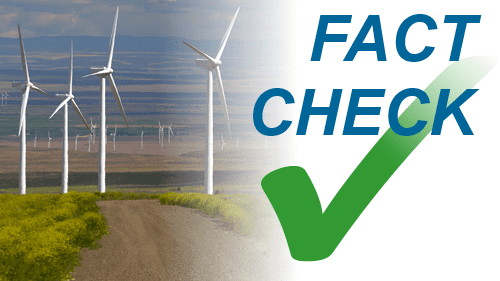Fact Check: U.S. Fish and Wildlife Service clarifies proposed rule
This week the U.S. Fish and Wildlife Service (USFWS) proposed a new rule concerning its eagle conservation program. While the proposal would govern a number of different industries, some have reported the facts incorrectly and erroneously conflated it with wind energy.
As a clean energy source, wind energy contributes to eagle conservation by mitigating climate change, one of the major threats to eagles. While unintentional take of eagles can occur from wind energy production, it is relatively uncommon and, based on a legacy of care, the U.S. wind industry does more to address its impacts on eagles than any of the other sector through constantly improving siting and monitoring techniques.
USFWS Director Dan Ashe penned an op-ed in The Huffington Post to further clarify the new proposal. He explained,
Contrary to published reports, proposed changes to our Eagle Conservation and Management Program do not give wind energy companies — or any other industry, organization or individual — license to kill thousands of eagles each year without consequence. The notion that we intend to permit the killing of more than 4,000 bald eagles is wrong. Period. That number appears in our proposal only as a scientific reference point that signals the “tipping point” at which our biologists tell us overall eagle populations would be at risk.
In reality, our conservation proposal will reduce harm to bald and golden eagles at a national and local scale. We’ve set very conservative limits on eagle mortality (from all sources, not just wind) to ensure healthy, sustainable populations. We require mitigation for any golden eagle deaths that exceed those levels — in addition to the conservation measures we impose in exchange for permits.
The truth is, thousands of eagles die every year for a variety of reasons — most from natural causes. The vast majority of human-caused deaths result from intentional poisoning and shooting — federal crimes that we aggressively investigate and prosecute. Most other eagle deaths are caused by collisions – with cars, buildings, power lines and other structures. Wind energy facilities represent a fraction of these deaths, and the media’s singular focus on wind turbines is a gross distortion of the truth.
We certainly recognize that our nation and the world need renewable energy development to reduce the severity of climate change impacts on eagles and hundreds of other native species. But the Bald and Golden Eagle Protection Act applies equally to the electric power industry, the oil and gas industry, the construction and aviation industries, and every other activity that may harm or kill eagles.
To learn more about the new USFWS eagle conservation program, see: https://acpqa.wpengine.com/fact-check-fws-eagle-take-permit-applies-to-number-of-different-industries/.





